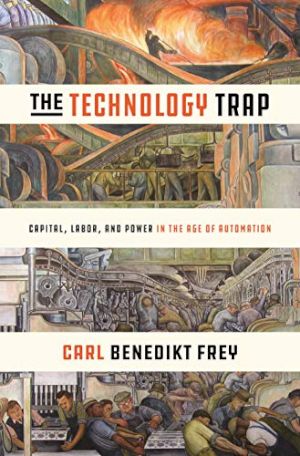02 December 2019
The Technology Trap:
Capital, labour and power in the age of automation
Carl Benedikt Frey
2019, Princeton University Press, 366 pages,
ISBN 069117279X
Reviewer: Rosemary Connell

The book focuses on the history of technological change in the UK and America but includes some comment on other areas, such as China and Europe. It takes a sweeping look at the history of technological progress in the first and second Industrial Revolutions and the computer revolution. The author describes how the development of political and economic power in society has changed.
This scholarly work is littered with quotations from other writers and researchers.
He ends with a short section on the possible future scenarios for work and technology and what could be done to reap the benefits of future advances in technology.
The author concludes that the Industrial Revolutions have been of enormous benefit in the long -term despite short- term opposition to the changes. Artificial Intelligence (AI) has the same potential, but short-term management is key as is learning from the past.
Before the late nineteenth century resistance to labour replacing technology was the rule rather than the exception. Waves of riots swept across Europe and China. The British government was the first to side with the industrialists rather than the rioters helping Britain to be in the forefront of industrialisation.
The author provides fascinating glimpses of technological achievements from before the Neolithic age to the Industrial revolutions. Not many of these resulted in economic progress without time lags as Guilds and others were successful in blocking technology that threatened employment. Cheap labour provided little incentive to replace it with capital. Before the industrial revolution Britain’s political power was in the hands of the landed classes. Once the rulers sided with the industrialists, industry began to mechanise.
The development of agriculture and increases in productivity often led to population growth so standards of living for the majority did not rise. Numerous inventions were not made into functioning prototypes, as exemplified by Leonardo da Vinci’s ideas.
As mechanisation progressed profits surged and Britain’s competitiveness in trade was secured. The rise of steam power and the growth of factories led to dire working conditions especially for child labour. Railroads revolutionised transport and communications.
In the later stages of the industrial revolution more complex machines required skilled workers. Technology was mostly enabling so met with little resistance. Industrialisation proceeded at different paces in Europe. With the second Industrial revolution of the 1870s, (following electrification and the internal combustion engine) the USA took over technological leadership.
The age of mass production arrived. The home was mechanised as was the office. The development of the motor vehicle transformed cities and agriculture. It was the horse that lost its job. Productivity increased, people worked less hours, had more leisure time, and women had time to enter the labour market.
Digital industries clustered where populations are skilled. Jobs have come and gone unevenly leaving parts of America jobless and prone to crime. Globalisation, automation and new digital technologies have shattered communities. Union power has declined. Since the great recession robots have increased by some 50% in USA. The world’s fastest computer is now in China despite American efforts to keep ahead.
Employment prospects depend on what computers can and cannot do. The rise of AI and automation will make many jobs obsolete. AI means that computers can now “learn” from data samples. As data gets bigger algorithms get better. Neural Machine Translation (NMT) systems still lag human performance but may catch up.
AI is already highly accurate in facial recognition, disease diagnosis and speech recognition. Autonomous self-drive vehicles work best in structured environments so far but could reduce jobs enormously if lorries and other motor vehicles become self-driving.
The author has researched which jobs are most susceptible to automation and concludes that many are low income. Timing is more problematic and productivity gains are yet to come. Growth in high technology jobs and service employment is forecast. However, he warns that if governments fail to make the gains from economic growth more widely shared backlashes will occur.
The author suggests that the social costs of automation must be addressed by better retraining and education. Housing should be made available where jobs are by lifting restrictions on building. Transport infrastructure should be planned to enable people to get to jobs, perhaps with the development of Hyperloop transportation.
He is optimistic for the long run but only if the short run is managed well especially addressing the impacts on society and the distribution of wealth.
